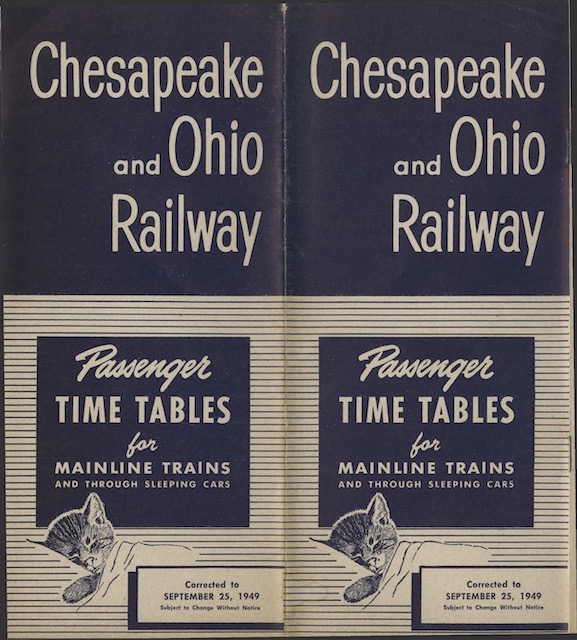The Chesapeake & Ohio was not big on passenger trains. Most railroads were still optimistic about the passenger business in 1949, but this timetable is so sparse it could be from the late 1960s. That’s partly because it is for “mainline trains,” meaning it is a condensed timetable, but even so it reveals some gaps in C&O’s passenger system.
 Click image to download a 4.1-MB PDF of this 8-page timetable.
Click image to download a 4.1-MB PDF of this 8-page timetable.
Most importantly, a map in the timetable shows the C&O’s main line went from Washington to Chicago via Cincinnati, but its passsenger trains only went as far west as Cincinnati. A few cars went on to Chicago on the New York Central but most passengers had to change to a New York Central train.
Another gap is between Chicago and Detroit: Between C&O and its subsidiary Pere Marquette, C&O had a direct line from Chicago to Detroit and on to Buffalo. But C&O only ran trains between Chicago and Grand Rapids, while the Pere Marquette ran trains between Grand Rapids and Detroit. The trains did not connect at Grand Rapids at convenient times, and no C&O passenger trains went between Detroit and Buffalo.
At least C&O ran three trains a day on the Washington-Cincinnati route: the George Washington, the F.F.V. (which stood for Fast Flying Virginian), and the Sportsman. The George Washington was the premiere train and the only one to have through sleeping cars from Washington to Chicago — but not from Chicago to Washington.
Coach passengers on the George Washington going through to Chicago would have crossed the platform in Cincinnati to the New York Central’s James Whitcomb Riley, which was scheduled to depart the same moment the George Washington was supposed to arrive. This didn’t allow enough time to switch a sleeping car from the George Washington to the Riley, so sleeping car passengers went on the Chicago Special, which departed 50 minutes after the Riley and arrived in Chicago almost two hours after the Riley. Returning, both coach and sleeping car passengers would have taken the Cincinnati Special to Cincinnati before connecting with the George Washington after a 55-minute layover.
Neither the F.F.V. nor the Sportsman had through cars to/from Chicago. Passengers on the F.F.V. could connect with a New York Central train called the Sycamore after a 75-minute layover in Cincinnati. Returning, they probably would have taken an unnamed overnight train, #410, which arrived in Cincinnati four hours before the F.F.V. departed.
The Sportsman arrived in Cincinnati 90 minutes before the George Washington, so its passengers could also take the James Whitcomb Riley to Chicago. They would return on the Central’s Carolina Special (which was bound for Charleston, SC, on the Southern Railway), arriving in Cincinnati 80 minutes before the Sportsman departed.
While the main part of each train went to or from Washington (and thence to New York on the Pennsylvania Railroad), another section came from Phoebus, Virginia, home of Fort Monroe, near to Langley Air Force Base, and next door to Newport News. The two sections merged or split at Charlottesville, Virginia. The George Washington had through sleeping cars from Phoebus to Chicago, St. Louis, and Cincinnati while the Sportsman had through cars from Phoebus to Chicago and Detroit. In 1952, Phoebus consolidated with the city of Hampton.
